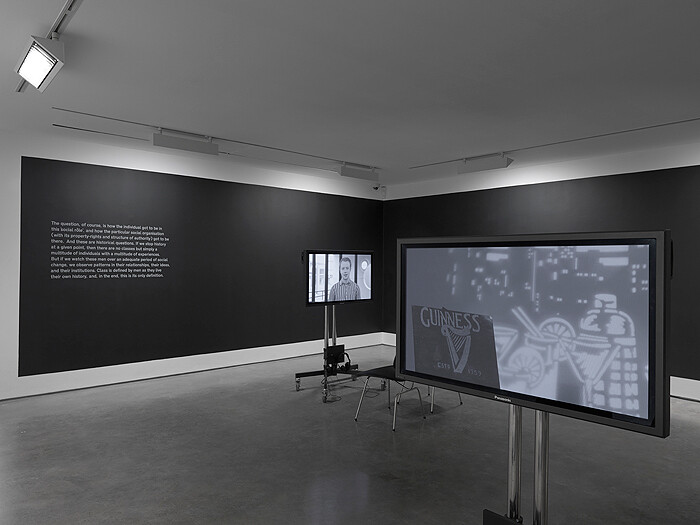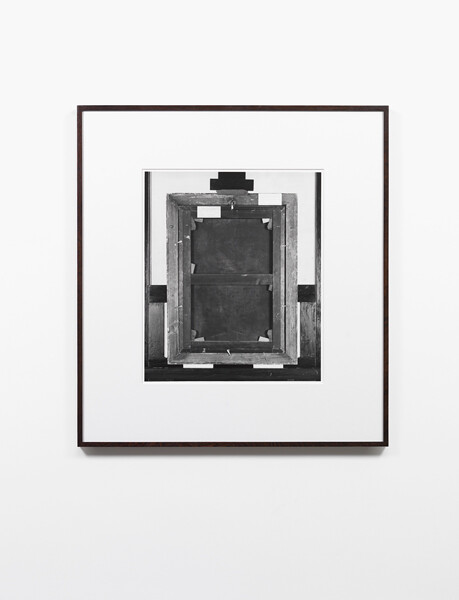To adequately reflect on the present moment requires a certain distance, some way of pulling out of the perpetual now of contemporary time and into another. This phenomenon can be evidenced in the compression of time that occurs when attempting to recall the near past; years turn into events and decades into fashions. Hindsight, as this is usually referred to, posits the notion of an ability to see something clearer from further away, from a distance. Gerard Byrne’s “Present Continuous Past” is not about the accuracy of a past represented so much as an attempt to collapse and flatten one differentiated temporality into another. The show itself is framed as an accompaniment to Byrne’s current survey exhibition “A state of neutral pleasure” at Whitechapel Gallery.
In its most literal sense, “hindsight” would imply seeing the back of something, the behind. Byrne’s 2013 series of silver gelatin prints—such as Inventory number 3280, a depiction of the martyrdom of St. Quirinus, photographed in the Belvedere Museum, Vienna, 219 years after it was painted, and reproduced here at 68% of its original size—depict the backs of framed canvases, in a continued reference to Cornelius Gijsbrechts’s 1670 trompe-l’œil Reverse Side of a Painting, the back of which Byrne photographed in 2008. A further distancing occurs here, however, as Byrne portrays these paintings as held on easels, and the black-and-white prints themselves are surrounded by mat board. No longer trompe-l’œil, these images register double modes of representation, not only to the history of painterly realism but also to contemporary photographic documentation, the kind that validates the authenticity of works. In making visible what is usually concealed, the relation between image and object is brought to the fore, a premise the sculptural work John Brown’s gallows, from existing photographs (after Noguchi) (2013) takes literally in reconstructing a photograph of Noguchi’s theater prop into an object.
Images or shadows of divine things (2005–ongoing), an edited accumulation of seemingly disparate black-and-white shots of suburban America, shifts this concern with image and object to another remove. The work is prefixed with a wall text quoting Perry Miller on the eighteenth-century theologian Jonathan Edwards, a text itself quoted in the opening of Michael Fried’s canonical essay “Art and Objecthood” from 1967. The text posits Edwards’s notion that the contingency of time allows for the constant ceasing and non-identical renewal of things, a newness of content relative to context. The images that make up this series are of things bygone: old cars and antiquated shop displays, street scenes and old houses, which, in addition, are not all shot by Byrne, but are rather commissioned by him and so are accumulated at yet another remove. This distance, rather than portending any clarity, proposes to condense the relation between past and present things in order question their differentiated status. The notion is reiterated in Byrne’s Kodak’s Wratten filter system (1912–2012) (2013), a series depicting overlapping colored filters in a combination of stock from different eras.
The three-channel video work Subject (2009) extends this logic from the selection of images into their temporal sequencing. On three monitors spaced throughout the room, one can see different sequences of vignettes filmed in the modernist University of Leeds expansion built between 1963–1975 by the under-appreciated Barbican architects Chamberlin, Powell, and Bon. Within these monumental environments, actors play out documents acquired by the university library archives at that time; Byrne’s material ranges widely, from 1970s articles on sexual relations on campus and broadcast radio and television debates, through to poetry readings and early twentieth-century texts on spiritualism. Each monitor displays various combinations of scenes, some with the audio entirely removed and actions rendered mute. And it’s these distantiated shifts between contextual registers that most poignantly correspond to the wall quote from Edward P. Thompson’s 1963 preface to The Making of the English Working Class, which posited class as a historical relationship rather than a thing.
In this sense, “Present Continuous Past” is less concerned with making one thing into another, an image into an object, than with the critique implied by foregrounding the relations between them. The works are a meditation on classification and value but also gesture towards putting the contemporary present at level with modernism’s past. What is at stake, perhaps, is the propensity for transfiguration, not just on the terms of image making but also as an allegory for social change. At the same time, the future here is only offered as a present relation to the past, always renewed again but also always contingent upon.









